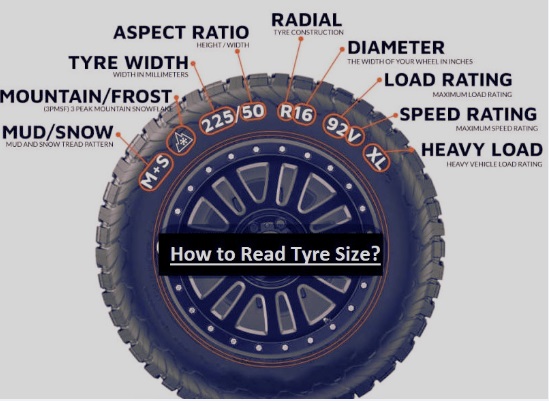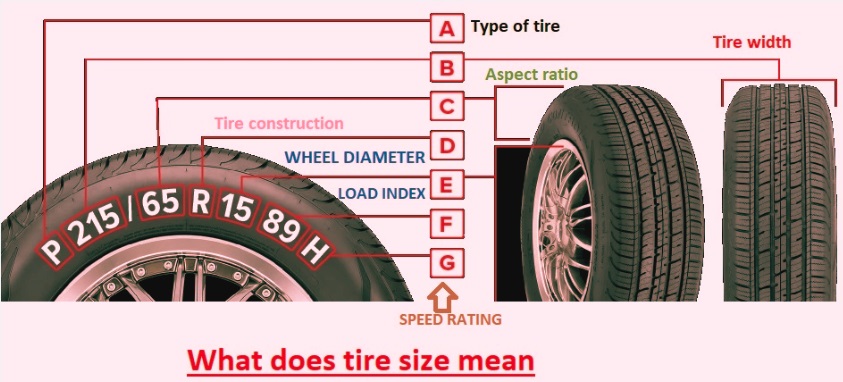The knowledge of accurate tire size is important for any vehicle. since it helps to maintain safety and make smooth driving if the proper-sized tire is used. For getting the right tire size, different details are needed; we will cover all guidelines here. Let’s get started. How to Read Tire Size?
What does “tire size” mean?
- Car tires, whether old or new, come with different numbers and symbols on them. So understanding the meaning of tire size numbers and symbols is important for every driver.
- These numbers are also important for the vehicle maintenance factor.
- Tire size is a code that gives details about dimensions and construction in a fit form. such as P215/60 R17, the ‘P’ shows tire class, and ‘215’ is the width in millimeters.
- 60 is the height-to-width ratio, R shows radial design, and 17 is the wheel diameter in inches.
How to Read Tire Size
tire comes with different numbers and shows certain details
type of tire
In the tire code, the first is an alphabetical letter that shows details about the TYPE of tire.
- The P letter shows that this tire is for a passenger vehicle. P-type are used for crossovers, minivans, SUVs, and pickup trucks.
- It is also part of electric vehicles, where accurate load capacity occurs in EVs. In electric vehicles, EV letters are shown.
- On some tires, LT exists to indicate a light truck tire, that part of the vehicle that carries heavy loads, tows trailers, and performs heavy-duty operations.
- ST CODES are used for special trailers. this size code is part of trailer tires, like 5th wheels and travel trailer and boat
Tire width
- After the letter, a three-digit code is written, like 215, that gives details about tire width in millimeters. It is also called section width.
Aspect ratio
- After the tire width number, another number separated by a slash shows the aspect ratio.
- A larger aspect ratio means a larger tire sidewall, and it is also known as a profile.
- aspect ratio: Define the sidewall of the tire in percentage. That is the height of the sidewall taken from the rim to the upper tread and defined as a percentage of the tire width.
- In the above figure, the aspect ratio is 65, which shows the sidewall is 65 percent as high as the tire width.
Tire construction
- letter used for tire inner construction, like it shows tire radial and bias
Radial Tires
- The letter R is used for the indication of radial tires; this is a commonly used industrial standard. It provides a good and strong grip, reduces rolling resistance for good electric and gas ranges, and gives a comfortable ride.
Diagonal Plies
- Some tires come with the letter D and come with diagonal plies; these are called bias-constructed tires.
- It is also known as conventional, X-ply, or cross-ply tires. Trailer tires used this inner structure.
WHEEL DIAMETER
- After inner construction, 2 digits show the wheel diameter in inches. That shows the distance between two bead seat locations
LOAD INDEX
- tire load index comes with a two or 3 digit number that helps give details about the gap
- load index shows the weight of the tire that can be supported. Here we have a 89 load index, load capacity is 1279 pounds.
SPEED RATING
-
- In the last of the tire codes, an alphabet letter exists that shows the tire speed rating.
- This shows high speed for safe travel. Tires with higher ratings provide good heat and give control at high speed.
- The maximum operating speed is not higher than the lowest speed rating of tires configured on vehicles.
Different symbols are used to denote speed rating.
- L USED FOR trailer and boat tires. that has the highest speed rating of 75 mph. M is used for a speed range of 87 mph (140 km/h).
- N used for speed about 81 mph in different conditions. This rating is mentioned on spare tires.
- P is used for the speed rating of tires: 93 mph (150 km/h) in normal conditions. These tires are not common.
- Q-letter tires are used for speeds of about 99 mph (160 km/h) in normal conditions. Winter season Q speed rating tire used.
- R speed rating used for 106 mph (170 km/h). This tire is used for maximum speed features. R-speed tires are rare and used for heavy-duty light truck (LT) tires.
- S speed rating: Tires can move with a speed of 112 mph (180 km/h). Passenger vehicle tires use speed-rated tires. S tires have a good speed configuration.
- T rating is used for getting a speed of 118 mph in optimal conditions. T-speed tires are used for standard touring tires and passenger vehicles.
- • An H speed rating shows a tire speed of about 130 mph (210 km/h) in normal conditions. The H speed rating lies at the low end of the performance tire speed rating. H-based tires are used for luxury coupes and sedans, full-fledged performance vehicles.
- V rating shows a speed rating of 149 mph under optimal conditions.
DOT Symbol
- Each tire sidewall used in the USA comes with a DOT symbol that shows details about the Department of Transportation on the sidewall.
- It shows that tires fulfill the requirements of Federal Motor Vehicle Safety Standards.
TIN
- TIN serial number that shows the code given to each tire, which is written after the DOT CODE.
- TIN comes with 8 to 13 letters or numbers that show different features. It gives details about the manufacturing industry, the manufacturing code, and the date of manufacturing.
UTQG
- UTQG defines Uniform Tire Quality Grading. That is a rating assigned by the Department of Transportation.
- that give details about tires according to some features like temperature, traction, and treadwear.
- Traction grades get the wet traction features of the tire during controlled testing. An AA-rated tire provides good traction for driving in wet conditions.
- The temperature grade helps to get tire features to handle and dissipate heat. A high value of temperature grade gives good handling at high speed. An A-rated tire manages more than 115 mph.
Tire Size Charts
| LOAD INDEX | SPEED RATING | |||||||
| LOAD INDEX | LOAD (lbs) | LOAD INDEX | LOAD (lbs) | LOAD INDEX | LOAD (lbs) |
SPEED SYMBOL
|
SPEED (mph) | |
| 65 | 639 | 94 | 1477 | 123 | 3417 | A1 | 3 | |
| 66 | 661 | 95 | 1521 | 124 | 3527 | A2 | 6 | |
| 67 | 677 | 96 | 1565 | 125 | 3638 | A3 | 9 | |
| 68 | 694 | 97 | 1609 | 126 | 3748 | A4 | 12 | |
| 69 | 716 | 98 | 1653 | 127 | 3858 | A5 | 16 | |
| 70 | 739 | 99 | 1709 | 128 | 3968 | A6 | 19 | |
| 71 | 761 | 100 | 1764 | 129 | 4079 | A7 | 22 | |
| 72 | 783 | 101 | 1819 | 130 | 4189 | A8 | 25 | |
| 73 | 805 | 102 | 1874 | 131 | 4299 | B | 31 | |
| 74 | 827 | 103 | 1929 | 132 | 4409 | C | 37 | |
| 75 | 853 | 104 | 1984 | 133 | 4541 | D | 40 | |
| 76 | 882 | 105 | 2039 | 134 | 4674 | E | 43 | |
| 77 | 908 | 106 | 2094 | 135 | 4806 | F | 50 | |
| 78 | 937 | 107 | 2149 | 136 | 4938 | G | 56 | |
| 79 | 963 | 108 | 2205 | 137 | 5071 | J | 62 | |
| 80 | 992 | 109 | 2271 | 138 | 5203 | K | 68 | |
| 81 | 1019 | 110 | 2337 | 139 | 5357 | L | 75 | |
| 82 | 1047 | 111 | 2403 | 140 | 5512 | M | 81 | |
| 83 | 1074 | 112 | 2469 | 141 | 5677 | N | 87 | |
| 84 | 1102 | 113 | 2535 | 142 | 5842 | P | 93 | |
| 85 | 1135 | 114 | 2601 | 143 | 6008 | Q | 99 | |
| 86 | 1168 | 115 | 2679 | 144 | 6173 | R | 106 | |
| 87 | 1201 | 116 | 2756 | 145 | 6393 | S | 112 | |
| 88 | 1235 | 117 | 2833 | 146 | 6614 | T | 118 | |
| 89 | 1279 | 118 | 2910 | 147 | 6779 | U | 124 | |
| 90 | 1323 | 119 | 2998 | 148 | 6944 | H | 130 | |
| 91 | 1356 | 120 | 3086 | 149 | 7165 | V | 149 | |
| 92 | 1389 | 121 | 3197 | 150 | 7385 |
ZR*
|
W | 168 |
| 93 | 1433 | 122 | 3307 | Y | 186 | |||
| (Y) | Above 186 |
some parts of TYRES
Some terms and main parts of tires are as
Tread
- • The tread is the tire part that makes contact with the road. In wet conditions, tread removes water away from the tire for good grip.
Bead
- This part makes a connection with the rim on both sides that runs inside. connected with air pressure in the tire, slots between the pop-out beads
Sidewall
- The tread and bead are connected at this point. The sidewall of tires comes with data about working.
Carcass
This is the fundamental structure of a tire, and it takes up to 80% of the stresses it experiences. In order to keep the tire’s shape & strength, rubber-coated fibers are bonded to the bead.
FAQs
What do tire sizes mean?
- This is measured in millimeters and gives the distance between the internal and external sidewalls of the tire. The number 205 means the tire is 205 mm wide. The second number shows the relation between the tire sidewall height and width and is shown in percentage.
What does 205/55R16 mean?
- The first number, 205, shows the tire width in mm. The 2nd number, 55, indicates the height of the tire as a width percentage. The letter R shows the radial type of tire. The number 16 shows the wheel rim in inches.
How to read tire sizes in inches?
- In inches, the tire size is difficult to read compared to millimeters. like if you have a tire size of 37X15.55R20.
- Here, 37 and 15 give the diameter and tire width. 55 shows the aspect ratio of the tire.
- 20 shows rim sizes in inches,
How to read a motorcycle tire size?
- Motorcycle tires come with the same tire-size features as car tires. The first three numbers give the tire width in mm. The other two are aspect ratios that give the height taken from cross-section to the width
What is the importance of aspect ratio?
- • A high value of the aspect tire ratio shows the sidewall is larger. Trucks, luxury cars, and buses come with about a 95 aspect ratio. These tires give good and safe riding since they have high air in the tires.
- Tires with low side walls give good handling.

